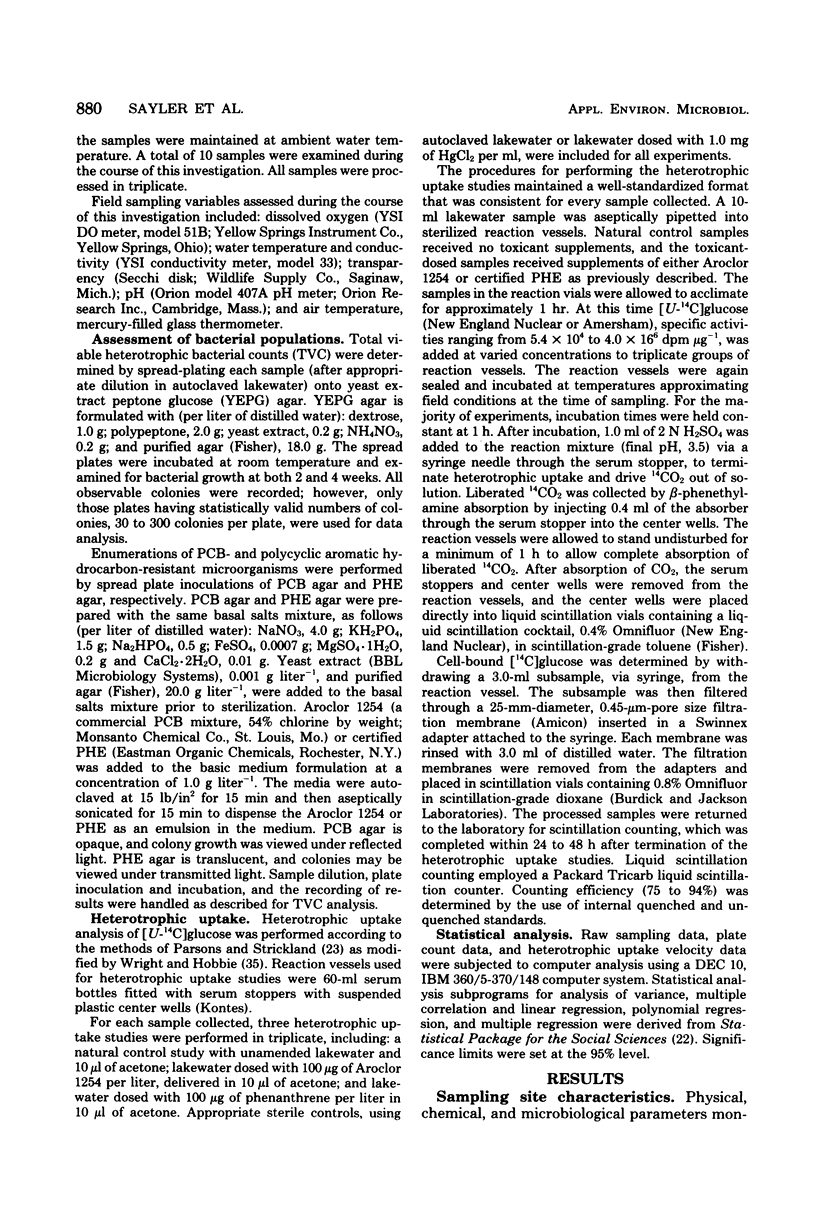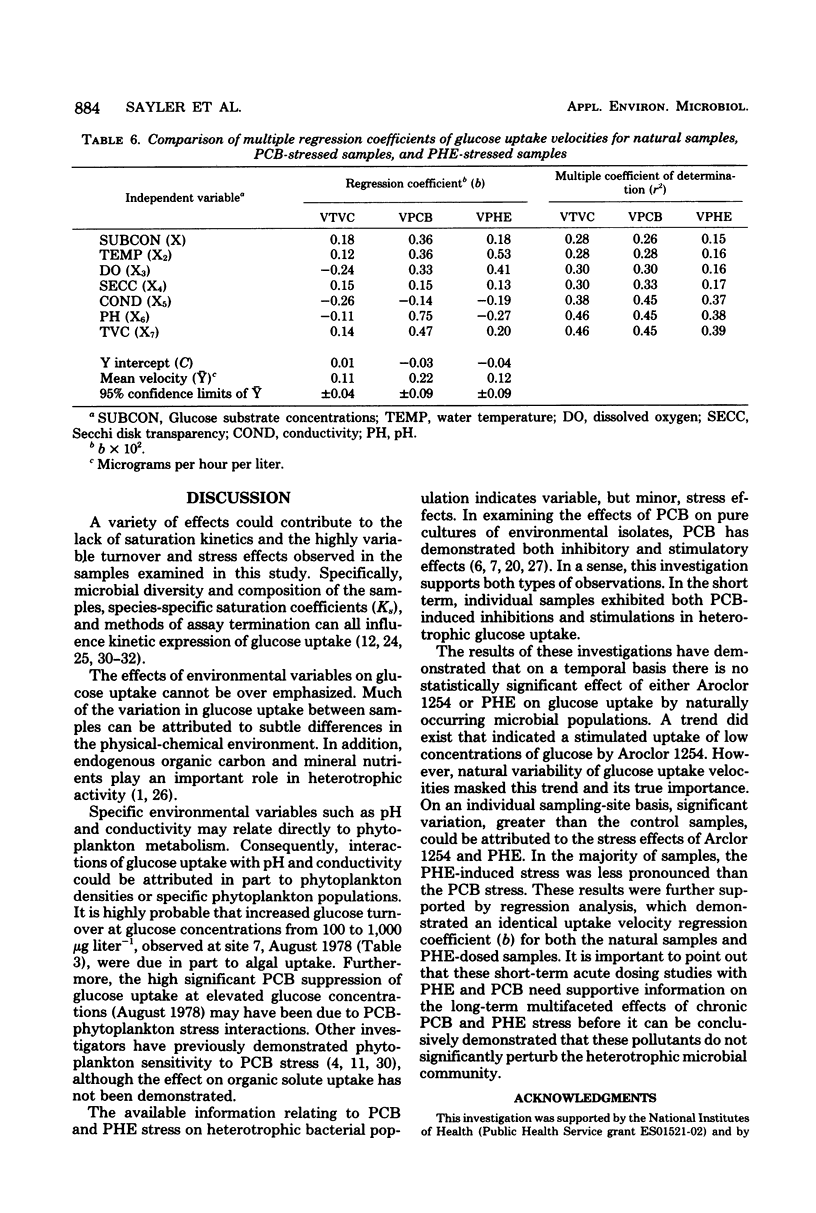Abstract
The effects of polychlorinated biphenyl (PCB) and phenanthrene stress on glucose uptake by natural microbial populations were examined by the heterotrophic potential technique. Temporal and spatial distributions in glucose uptake velocities were examined for natural samples as well as PCB- and phenanthrene-stressed samples. Statistical analysis indicated significant variability among the various samples. It was demonstrated that the environmental variables contributed significantly to the variability in uptake kinetics. Although general trends indicated a PCB-induced stimulation in uptake velocities, these trends were in part masked by sample variability. Data analysis indicated no statistically significant PCB or phenanthrene effect on either total glucose uptake velocities or the proportion of 14CO2 evolved, as compared to natural unstressed samples.
Full text
PDF







Selected References
These references are in PubMed. This may not be the complete list of references from this article.
- Blakemore R. P., Carey A. E. Effects of polychlorinated biphenyls on growth and respiration of heterotrophic marine bacteria. Appl Environ Microbiol. 1978 Feb;35(2):323–328. doi: 10.1128/aem.35.2.323-328.1978. [DOI] [PMC free article] [PubMed] [Google Scholar]
- Blakemore R. P. Effects of polychlorinated biphenyls on macromolecular synthesis by a heterotrophic marine bacterium. Appl Environ Microbiol. 1978 Feb;35(2):329–336. doi: 10.1128/aem.35.2.329-336.1978. [DOI] [PMC free article] [PubMed] [Google Scholar]
- Bourquin A. W., Cassidy S. Effect of polychlorinated biphenyl formulations on the growth of estuarine bacteria. Appl Microbiol. 1975 Jan;29(1):125–127. doi: 10.1128/am.29.1.125-127.1975. [DOI] [PMC free article] [PubMed] [Google Scholar]
- Crump-Wiesner H. J., Feltz H. R., Yates M. L. A study of the distribution of polychlorinated biphenyls in the aquatic environment. Pestic Monit J. 1974 Dec;8(3):157–161. [PubMed] [Google Scholar]
- Dagley S. Catabolism of aromatic compounds by micro-organisms. Adv Microb Physiol. 1971;6(0):1–46. doi: 10.1016/s0065-2911(08)60066-1. [DOI] [PubMed] [Google Scholar]
- EVANS W. C., FERNLEY H. N., GRIFFITHS E. OXIDATIVE METABOLISM OF PHENANTHRENE AND ANTHRACENE BY SOIL PSEUDOMONADS. THE RING-FISSION MECHANISM. Biochem J. 1965 Jun;95:819–831. doi: 10.1042/bj0950819. [DOI] [PMC free article] [PubMed] [Google Scholar]
- Fisher N. S. Chlorinated hydrocarbon pollutants and photosynthesis of marine phytoplankton: a reassessment. Science. 1975 Aug 8;189(4201):463–464. doi: 10.1126/science.807971. [DOI] [PubMed] [Google Scholar]
- Kaiser K. L., Wong P. T. Bacterial degradation of polychlorinated biphenyls. I. Identification of some metabolic products from Aroclor 1242. Bull Environ Contam Toxicol. 1974 Mar;11(3):291–296. doi: 10.1007/BF01685111. [DOI] [PubMed] [Google Scholar]
- Wodzinski R. S., Coyle J. E. Physical state of phenanthrene for utilization by bacteria. Appl Microbiol. 1974 Jun;27(6):1081–1084. doi: 10.1128/am.27.6.1081-1084.1974. [DOI] [PMC free article] [PubMed] [Google Scholar]
- Wodzinski R. S., Johnson M. J. Yields of bacterial cells from hydrocarbons. Appl Microbiol. 1968 Dec;16(12):1886–1891. doi: 10.1128/am.16.12.1886-1891.1968. [DOI] [PMC free article] [PubMed] [Google Scholar]


